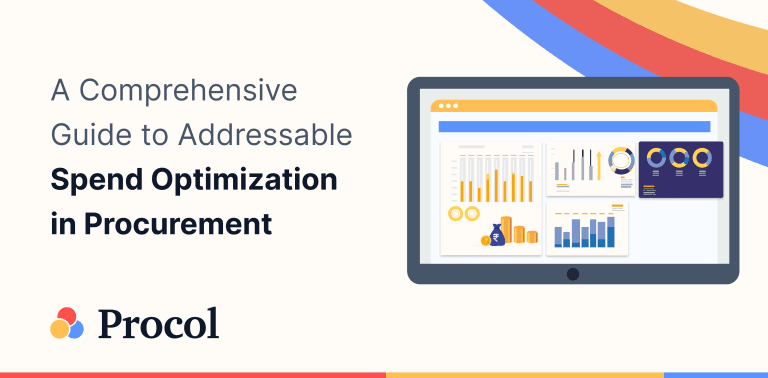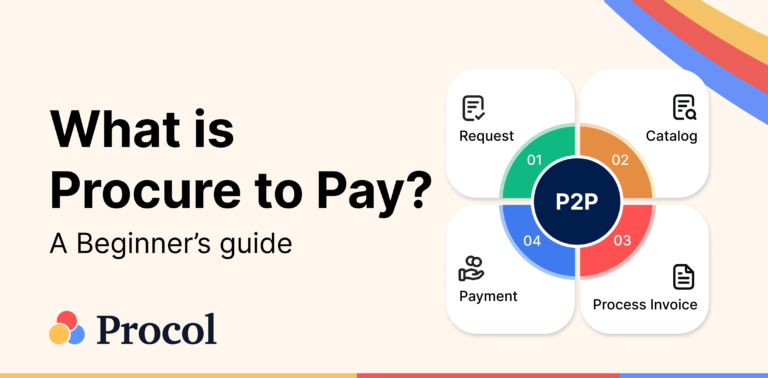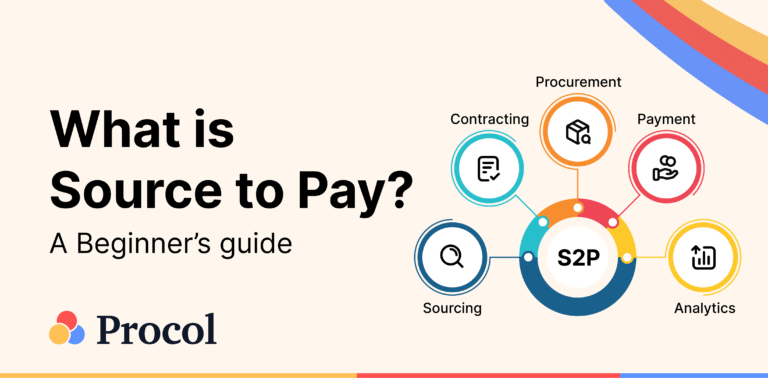Procol • April 15, 2025
A Comprehensive Guide to Addressable Spend Optimization in Procurement

Introduction
In an organization, professionals across all teams work together for business success. For example, the marketing department is all set to look for strategies, while procurement professionals have to review the spending.
Businesses look for cost reduction without harming product or service quality, and addressable spend evolved as an effective way for procurement teams to manage costs, efficiency, supplier relationships, and more, catering to the strategic goals of various business roles, from CFOs to procurement teams.
An addressable spend in procurement is the portion of the overall company’s spending that can be managed or influenced through various activities, such as procurement decisions, strategic sourcing, etc. Thus, optimizing the addressable spend will increase the chances of cost reduction, reduction in risk factors, etc., maximizing the procurement process.
In this guide, we will understand what is addressable spend definition, how it is distinguished from non-addressable spend, its benefits, and a roadmap for mastering addressable spend in procurement.
What is addressable spend?
To understand this term, first of all, one must understand the addressable spending definition. Addressable spend refers to optimizing a portion of a company’s spending. In other words, it is the portion of the organization’s total spending that can be managed and influenced by procurement decisions. The procurement department controls the money spent on buying goods and services. Addressable spend is critical for businesses as it helps procurement professionals identify resources that can be managed, optimized, and negotiated to achieve the required efficiency in procurement.
Why is Optimizing Addressable spend important?
Many business experts agree that if a company allocates resources efficiently over time, it will determine long-term success.
The procurement team looks at activities like sourcing or purchasing services and goods according to the company’s requirements. However, successful procurement organizations set robust policies to control the company’s spending and secure the supply chain. Addressable spending is a crucial strategy. Optimizing addressable spend in procurement streamlines the business cost and minimizes unnecessary spending on purchasing inventory.
The term addressable spend lets procurement officials create a strategic plan to target the company’s needs with minimal to no error. Hence, in this competitive era, companies must take a smart approach to allocating resources in order to reduce identifiable costs, thereby improving gross margin and profitability with addressable spend in your business.
Difference Between Addressable and Non-Addressable Spend
Well, moving further, we must first discuss addressable and non-addressable spend, as your company’s growing expenditures can be managed if you know the difference between the two. Dividing the company’s expenditures into two categories makes it easier to allocate costs and manage operations effectively. Here are the differences between the two:
| Addressable Spend | Non-Addressable Spend |
|---|---|
| Addressable spend definition is the cost, taken care of by the procurement team in an organization, such as the selection of suppliers, buying goods or services, contract management, contract negotiation, procurement activities, etc. | Non-addressable spend refers to the money that companies spend and does not come under the procurement department, such as taxes, employee salaries, real estate, etc. |
| Mostly, all activities in the organization come under addressable spend | It consists of non-operational activities. |
| It is crucial to manage operations in an organization. | It is essential for the functioning of an organization. |
| It involves specific procurement activities targeting consumers | It involves general research activities targeting a broader audience. |
| It has an optimizing potential | It has a fixed nature |
Benefits of Addressable Spend Optimization in Businesses
Optimizing addressable spend in a business has various benefits. It positively impacts business, like enhanced financial health, elimination of cash leaks, and operational efficiency. Here are a few benefits stated below:
-
Increased visibility: Optimizing addressable spend in a business leads to better decision-making, as procurement professionals understand every dollar spent and identify cost-cutting opportunities. In other words, addressable spending helps companies fix issues like unnecessary spending on future purchases of goods and services.
-
Risk mitigation: By optimizing the addressable spend, the procurement team might address various risks, like trade gaps, and encourage them to address the gap, avoid financial holes, and look for the best financial opportunities.
-
Stronger supplier relationships: It enhances communication and collaboration with suppliers, building mutually beneficial relations that allow each to prosper. The team can quickly negotiate by understanding the amount spent on a particular supplier. This ensures better services, increased efficiency, quality, and vendor support when issues arise.
-
Enhancing company value: Addressable spend increases the organization’s value by lowering costs and minimizing risk potential. Moreover, addressable spend lets the procurement team work on other important tasks, without working on potential errors.
-
Stronger cash position: Maximum spending comes under addressable spend. So, if the procurement team manages the spending, it strengthens an organization’s financials, such as investment opportunities, fund growth, etc. It will also lead to a better understanding of spending data, allowing for more informed decisions. Furthermore, it lets the procurement team in a company allocate resources efficiently.
-
Less invoices: Addressing spend optimization results in close vendor-buyer relationships, meaning your maximum spending happens with fewer vendors that supply a more significant percentage of your business needs. As a result, there are fewer invoices to process.
-
Data-driven decision-making: It provides valuable insights into the organization’s spending pattern in various departments for better decision-making. Thus, businesses can determine cost-saving options that were earlier neglected and prioritize investments accordingly.
-
Cost reduction: Businesses can significantly lower expenditures by recognizing inefficiencies and leveraging volume discounts. Simplifying procurement processes and working more effectively on contracts also contribute to a more robust bottom line and cash status.
What are the Key Strategies to Manage Addressable Spend in Procurement?
To manage addressable spend in procurement, the procurement teams come up with various strategies that will save cost and optimize procurement activities. Here are the strategies listed below:
-
Negotiation: Create better contacts or negotiate with suppliers by auditing the current business usage and needs by checking the usage of regular items or categories. This will help you understand your business needs better and, accordingly, negotiate for better rates with suppliers.
-
Volume-based discounting: Suppliers offer more discounts to bulk buyers, and if your business requirement is high, you can use bulk purchasing to secure discounts.
-
Usage reductions: The other strategy is usage reduction, which means looking for areas where usage can be minimized to reduce costs and increase profit margin.
-
Demand management: Addressing the current supply or service usage in your procurement contracts is an easy and effective way of decreasing spending costs. This is done by adjusting the procurement contract to match the usage. Thus, work with vendors to negotiate mutual pricing as per the increased volume at the time of more usage. Finally, this optimization improves value by facilitating supplier trade relationships and bolstering stability for both parties.
-
Category management: The other important strategy is to categorize a few preferred vendors that offer better pricing by meeting specifications and delivering products and services efficiently. The process focuses on spending patterns, trend assessments, and market performance to help procurement teams make better decisions and address particular spending goals. Thus, category management can work for companies of any size.
-
Supplier management: Supplier Management enables procurement teams to handle costs efficiently by focusing on supplier relationships. Building trust value among suppliers lets them cooperate better and negotiate good contract terms.
Effective Supplier relationship management allows better opportunities for sourcing quality goods and services. This process prioritizes suppliers as key players within the company’s procurement process. Sourcing a faithful supplier means the company can optimize its market value.
-
Spend analysis: A spend Analysis strategy lets you gather procurement data regarding a business’s costs and spending patterns. This process encourages the procurement team to optimize the company’s spending by facilitating available data. Therefore, come up with business opportunities like better spending procedures and exact approaches and make data-driven decisions.
-
Spend reduction: Spend Reduction means undergoing audits to ensure that all spending is required and valuable, thus eradicating wasteful expenses. It is an effective approach to optimizing spending within the company.
What is Total Addressable Spend?
TAS, or Total addressable spend, refers to the maximum money a business can capture or target from the market. It helps companies discover their business potential revenue by calculating the accessible consumer base and the average spending per customer across various segments.
Organizations can use Total addressable spend (TAS) to determine which consumer segments have the most significant spending power and strategize to target and capture them. TAS also makes measuring a business’s success and profitability easier over time, as it estimates progress against identified goals. Thus, TAS is the compass for understanding how to sail to stay on course.
How to Calculate Your Current Spend?
Analyzing your business’s current spend is essential in the optimization of addressable spend in procurement. This process involves checking the company’s purchasing history to identify areas for improvement.
Here are a few steps to analyze current spending:
- Collect data from sources such as purchase orders, receipts, and invoices.
- After collecting the required details, calculate expenses by categorizing them in the form of product or service type, vendor, and department.
- Identify problematic spending patterns, such as overspending on specific products or higher vendor rates than others, to pinpoint cost-saving possibilities.
- Another significant factor in analyzing your current spending is comparing your business spending with similar companies. It will give you a better idea of where your organization stands regarding efficiency and effectiveness.
Thus, analyzing your current spend requires a systematic approach that considers both quantitative and qualitative factors. Thus, the ultimate goal of calculating spending is to identify weak areas that require optimization. Ultimately, the procurement teams have to develop strategies for long-term business success in the future.
Conclusion
Optimizing addressable spend in procurement is critical for any organization seeking to achieve goals such as reducing costs, strengthening supplier relationships, and enhancing operational efficiency. By optimizing addressable spend, procurement teams can identify loopholes and implement strategies to streamline operations and effectively reduce costs while maintaining quality.
It’s important to note that optimizing addressable spend is an ongoing activity. However, with constant dedication, companies can achieve cost reduction without compromising their value.
Explore more from Procol
Discover expert tips, how-to guides, industry insights, and the latest procurement trends.

What is Procure-to-pay (P2P)? An Ultimate Guide
Procure to pay is the process from procurement of materials needed...

Best eSourcing Tools: Top 10 eSourcing Software in 2025
Discover top 10 e-sourcing tools and esourcing platforms necessary for efficient...

What is Source-to-pay in 2025? An Ultimate Guide
Source to pay is the process of sourcing vendors to procure...



















